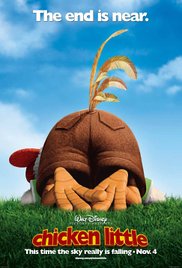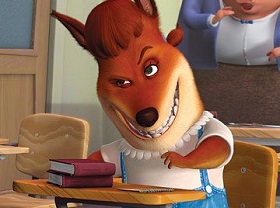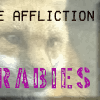Retrospective review: 'Chicken Little'
 So, anyway, earlier this year, a movie came out called Zootopia. We, uh, might have mentioned it. Despite being anticipated, or even known, by just about nobody who wasn't a furry or, perhaps, a major Disney fan, the movie managed to become a rare hit at both the box office and with professional critics (though gathering up Flayrah reviews, the consensus was more in line with Metacritic's "good, but whatever" score, because furries, am I right?).
So, anyway, earlier this year, a movie came out called Zootopia. We, uh, might have mentioned it. Despite being anticipated, or even known, by just about nobody who wasn't a furry or, perhaps, a major Disney fan, the movie managed to become a rare hit at both the box office and with professional critics (though gathering up Flayrah reviews, the consensus was more in line with Metacritic's "good, but whatever" score, because furries, am I right?).
One thing that was repeatedly and pointedly not mentioned by anyone involved with the movie was another movie a little over a decade old, called Chicken Little. Lots of interviews, and even a semi-independently produced 45-minute making of documentary, all went on at length at how this Disney's first fully anthropomorphic animal world since Robin Hood, and the first set in the furry equivalent of a modern world, despite the fact that it, well, wasn't. Chicken Little became the animated equivalent of a "disappeared non-person" in some sci-fi dystopia.
Which makes it incredibly interesting, in a weird kind of way; in a company that mines its past productions for nostalgia like there is no tomorrow (only yesterday, repeated), Disney has gone out of its way to avoid reminding anyone this movie exists. And this is actually a fairly important movie in the history of the company; it was the first full length computer animated feature by Disney (and not Pixar). So, is it really that bad?
Yes. Yes it is really that bad.
Animation
Let's get one unfair disadvantage the movie has out of the way at the beginning; over a decade later, the animation looks pretty dated. One of the drawbacks of CGI animated movies; technology that was cutting edge last year looks dated, never mind last decade.
And Disney didn't do itself any favors by choosing to do a furry movie straight out the bat (setting aside that the title character is actually, you know, a bird with feathers instead of fur). Talking animals have an advantage in traditional, hand-drawn animation; nobody expects you to draw every single strand of hair, much less animate them. But, in CGI, texture is everything, and is there a more headache inducing texture to animate this way than fur (or feathers)? Pixar was much smarter; in age when a fully CGI movie would most likely look like a bunch of talking dolls, they decided to make a movie about, well, a bunch of talking dolls (it helps, given the evidence of both his earlier shorts and later movies, Pixar is run by apparent anthropomorphic inanimate object fetishist John Lasseter). Rival DreamWorks went with relatively textureless bugs for their CGI debut; however, their character of Puss in Boots is the perfect illustration. Compared to his appearance in 2011, his 2004 debut looks a little ragged.
But, you know what, I can still watch Shrek 2 and enjoy it in a way the filmmakers intended me too. Not so with Chicken Little.
The Humor
But let's keep with the subject of Shrek; trust me, this is important. Nowadays, it's kind of an embarrassment it won the inaugural Best Animated Feature Oscar; when Time Out New York polled film critics and animation experts on the 100 best animated movies, Shrek was conspicuous in its absence while fellow inaugural Best Animated Feature Oscar nominee Monsters, Inc. made the top 50. However, while time has not been kind to Shrek, it was kind of a big deal. It still boasts a pretty impressive 88% on Rotten Tomatoes, and it is still the only non-Pixar animated movie to be nominated for a Best Screenplay award at the Oscars, and only one of two to be nominated for the generally more competitive Adapted Screenplay category. It was also the only non-Disney film nominated for Best Picture (Musical or Comedy) at the Golden Globes.
Chicken Little is very obviously Disney's response to Shrek; it had a similar post-modern take on its stock in trade of fairy tale adaptations. But, while Shrek gained whatever power it held from the fact that it was actually an angry assault on Disney and everything Disney's animation studio stood for by a group of hungry outsiders, Chicken Little didn't have that advantage. It's hard to stick it to the Man when, technically, you are still a part of the Man. Shrek was storming the castle in the Disney logo; Chicken Little was just following its lead, because at around the time Chicken Little would have been greenlit, Shrek was the model for CGI animated blockbusters. If you wanted to make one, you made fun of Disney. Even if you were Disney.
So, Chicken Little opens with a montage of older Disney openings while in voice over, Garry Marshall (in the role of Buck, the title character's father), assures us that this movie won't be like those movies. The movie then really opens with the title character (Zach Braff) doing his "the sky is falling!" bit; there is a bunch of manic slapstick, and, just to prove this isn't a Disney movie (even though it is), we even get a bit of the live action Raiders of the Lost Ark playing on a movie screen (this is called irony, folks), because pop culture references, duh.
The movie then decides to get meta; in universe, the whole incident goes viral, and before you know it, there is going to be a Chicken Little movie. Everyone assures the protagonist and his embarrassed father that surely the movie can't be that bad, and will be soon forgotten, and the (real) movie accidentally gets hilarious.
The World
Here's the interesting, thing, though. The story is actually really creative (I mean, once you get past a time-wasting subplot about baseball, anyway). It's a furry alien invasion story, which is an interesting, original idea (or at least was; this is called irony, again, folks), and even that has a twist. When you compare it to Zootopia, well, actually, buddy cop movies are kind of walking cliches. And Zootopia also uses the same kinds of humor; pop culture references abound, and a character explicitly references another Disney movie and says that this Disney movie is not that Disney movie.
But it's world-building is one area where Zootopia differentiates itself from Chicken Little. Going back to that opening scene, there's a joke where a rabbit mother grabs an infant bunny from a stroller, and this bunny is holding the hand of a sibling, who is holding the hand of another sibling, then the camera goes to something else, only to come back about a minute later to show baby bunnies still springing from the stroller. Zootopia does a variation on this joke, with rabbit characters referring to their 200 plus children and a bunny section of town featuring an ever upward spinning population counter.
But these two jokes, while basically the same, actually can be used to illustrate one of the key differences between the two movies. The rules of the world are set up in the openings; Chicken Little openly admits it is a movie, while the opening of Zootopia is also fictional, it is fictional for the characters as well as the audience, and is used by the characters to explain their world. Chicken Little doesn't explain where, for instance, its suddenly live action movie featuring a non-anthropomorphic animal star comes from, so why should it explain where all those bunnies are coming from? Who cares? It's a cartoon about a chicken.
Zootopia, on the other hand, explains things; this world has rules. Yes, a desert landscape should not exist next to a frozen tundra, but the movie takes time to explicitly show us that there is a giant machine sucking heat from one area and pumping into the next. Does the science actually make sense? Heck if I know. But the point is, this world has rules; in the real world, if rabbits bred that explosively, this would be a problem. And the movie makes clear that most, if not all, of the rabbits born survive to adulthood, and are probably having 200 plus children of their own. But, we don't see any fallout from this in Zootopia; the movie never solves the problem on screen, because Zootopia is not a movie about population control. I don't know how they are feeding all these bunnies, but the movie invites you to explain it, because things in Zootopia have explanations. I don't know how, but I'm just a guy writing a fun review about a different movie; I just want to think about this problem. Could a billion billion bunnies over thousands of years solve the problem, especially since they need to? Absolutely, I could believe that.
That's one big difference why Zootopia is the movie I'm going to prefer, but that's not why I think Chicken Little is a bad movie. That's going to need a bit bigger explanation.
The problem with Foxy Loxy

As I said earlier, Zootopia is not a movie about population control. So, what is it about, and what is Chicken Little about?
Basically, Chicken Little, thematically, is about the relationship between parents and their children. As far as themes go, sure, whatever, that's fine. I mean, not exactly breaking new ground for Disney, but whatever. It's fine. Zootopia, on the other hand, is thematically about biases and stereotypes between different groups of people, and the danger they represent to a society, both overtly and covertly. That's a much riskier proposition, and Zootopia gets some credit just for daring to tackle it at all. For minor themes, they also share a bit about bullying.
It needs to be pointed out that Zootopia is not an allegory; the main bias explored is between a rabbit and a fox. However, these characters are metaphors for biases in the real world; to put it in crude terms, this is not black and white, in the rabbit isn't a direct stand-in for a white person, while the fox is not black (the fact that the fox is played by one of the whitest actors in Hollywood should be a clue, but people seem to have had trouble taking the hint). This has two advantages; one, it allows the movie to talk about sensitive issues without saying "black people are predators," and it also allows the movie to talk about more than just racism.
One of these areas of bias explored is gender bias, and this area, even if it isn't, Zootopia feels like a direct reaction to the gender politics of Chicken Little. Which are horrible.
The movie features a minor antagonist in the character of Foxy Loxy (Amy Sedaris), who begins the movie as a strong, independent, non-stereotypical female character, and ends the movie, well, we'll get to that in a moment. Suffice it say there are actually two problems with Foxy Loxy, and one doesn't involve her gender. She's a bully, and while that isn't a problem for the movie (I mean, it's obviously a character flaw for Foxy, but having a minor villain isn't a flaw for a movie), and is in its own strange way, oddly positive in its representation of what a female character can be, it's how the bullying is represented that is problematic.
See, the movie opens up with slapstick destruction on a wide scale; it's already established, no matter chaotic it gets, half a city being leveled is not that big a deal, and is something to be laughed at. I'm not saying destruction of cities should only be shown in the most serious of lights, if at all, in movies (I hated Man of Steel, too). I am saying that this movie has set up that this slapstick violence is something to laugh at. So, when Foxy physically abuses other characters, and they bounce around like rubber balls, complete with zany sound effects, well, we've been told by the movie it's okay to laugh.
Compare this to scenes of bullying in Zootopia, which are the opposite. They are presented as the traumatic events they really are. They leave scars, both physically and emotionally, in the characters' lives. They are not okay to laugh at.
And when I say they leave scars, I'm not just talking about the victims; Gideon Grey, the Zootopia equivalent of Foxy Loxy, is shown to be just as haunted by his actions as his victim. He has small but important role, with a mostly off screen, but important character arc, with repercussions for both the thematic and plot elements of his movie. His character growth is ultimately a hopeful addition to the movie, valuing forgiveness and understanding over punishment and shunning.
This is not Foxy Loxy's character arc. At all.
The character is accidentally brain damaged late in the movie (and, yes, it is brain damage; another character literally calls her broken, but fixable); she loses her former interest in sports and instead instantly changes into a pink dress and a blonde wig (no, really) and starts singing insipid pop songs and doting on the nearest male supporting character. Oh, and though the movie makes clear that this is not who she is or who she wants to be until she is literally brain damaged without her consent, the characters decide, you know what, we're going to leave her like this. She's better this way. No chance for character growth, or a true change of heart. Just a literal male chauvinist pig going "I like her better this way."
So, I really don't like this movie.
Conclusion
So, why did Disney pretend this movie didn't exist? Because they probably wish it didn't. I mean, thanks to e621.net and its freaky obsession with tags, I know it barely exists in the mindspace of the furry fandom. I am so not going to prove it with a link, but there are a total of two pieces in that entire site. Yes, of course they're porn. Furries, am I right?
Maybe, for once, furry smut is the proper level of respect.

About the author
crossaffliction (Brendan Kachel) — read stories — contact (login required)a reporter and Red Fox from Hooker, Oklahoma, interested in movies, horror, stand up comedy
Formerly Wichita's only furry comic.
Comments
I'm going to have to rewatch this one, it's been a long time since I viewed it. My reaction was positive enough that I felt it worth adding to my movie library... but I can't remember enough of the finer details to respond.
You'll be sorree... I agree with crossie. "Chicken Little" is painful to watch.
It is due a place on one of Hollywood's exclusive lists, though. It was an animated feature that was the final performance of a Hollywood great actor, just like "Fievel Goes West" was Jimmy Stewart's final role. In the case of "Chicken Little", it was Don Knott's last role.
Fred Patten
It might be worth mentioning that Disney produced an animated short Chicken Little in 1943, in which the villain was also named Foxy Loxy but was male. I haven't seen either so I'm not in a position to speculate on any other similarities or differences between the two.
In Disney's 1943 "Chicken Little", Foxy Loxy figured out how to scam the stupid fowls by studying "Mein Kampf". It was topical at the time.
Fred Patten
Can we block people on Flayrah? I don't want to see another post or comment by crossaffliction after reminding me of this movie. >:(
Actually, I don't know if the ignore user button works on articles ... :(
It does. :-)
*chuckles*
Blocking someone over reviewing Chicken Little give cockblock a whole new meaning.
Furries, am I right?
Foxy Loxy was one of the characters (antagonists) from the original folk tale, so of course he/she is going to be in the adaptations.
At the time Disney's CGI Chicken Little came out, some of us (the well-known and the not-so) were carping that there were two characters (Foxy Loxy and Runt Of The Litter)whose character arcs seemed to be starting off as rather cliche "gay" characters -- only to end up in a loudly "straight" relationship, and declaring this was "the better way". That was not appreciated.
To be fair (or at least honest) there was one (ONE) little aspect of Chicken Little that I found actually rather charming: The budding romance between Chicken Little and Ugly Duckling is presented in a way that feels very organic and believable. It was well-presented enough it felt like it belonged in another movie.
I know this article is a few months old now, but I figured I'd point this out since I knew I saw it at some point and recently was pointed out where to find it (during Nick's mocking lecture to Judy early in the movie):
![]() https://i.gyazo.com/56462d4b0a70c7ed98ab37d1c8d3386b.png
https://i.gyazo.com/56462d4b0a70c7ed98ab37d1c8d3386b.png
"Could it be time to get yourself... FIXED?" This is obviously a direct in universe PSA of sorts for rabbits (and less explicitly other quickly reproducing species). While I've seen people suggest Judy's family's size is just exaggerated for laughs and that the ticking sign is again just meant to be funny for tourists, that's just speculation. That sign there is right in the movie though, even if most wouldn't catch it.
Also I never saw Chicken Little. This makes me almost afraid to. The fact it largely escaped the fandom's attention speaks volumes though.
Post new comment